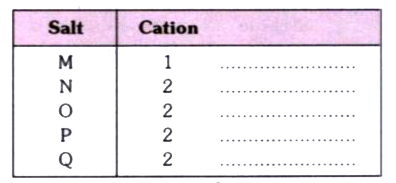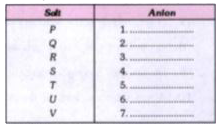Name a hydroxide which is soluble in excess of ammonium hydroxide.
Step-by-Step Solution:
1. Identify the Hydroxide: We need to find a hydroxide that is soluble in excess of ammonium hydroxide.
2. Consider Copper Hydroxide: One example of a hydroxide that fits this criterion is copper(II) hydroxide, which is represented as Cu(OH)₂.
3. Reaction with Ammonium Hydroxide: When copper(II) hydroxide is treated with excess ammonium hydroxide (NH₄OH), it reacts to form a complex ion. The reaction can be written as:
Cu(OH)2+4NH4OH→(Cu(NH3)4)2++4H2O
This results in the formation of a deep blue solution of the tetraamine copper complex ion.
4. Final Product: The final product of this reaction is the tetraamine copper complex ion, which is soluble in the solution:
Cu(NH3)2+4+2OH−
5. Conclusion: Therefore, the hydroxide that is soluble in excess of ammonium hydroxide is copper(II) hydroxide (Cu(OH)₂).
Final Answer: Copper(II) hydroxide (Cu(OH)₂)
---
Cu(OH)2+4NH4OH→(Cu(NH3)4)2++4H2O
This results in the formation of a deep blue solution of the tetraamine copper complex ion.
Cu(NH3)2+4+2OH−
Topper's Solved these Questions
- ANALYTICAL CHEMISTRY- USE OF AMMONIUM HYDROXIDE AND SODIUM HYDROXIDEBOOK - ICSECHAPTER - ANALYTICAL CHEMISTRY- USE OF AMMONIUM HYDROXIDE AND SODIUM HYDROXIDEEXERCISE - Questions from Previous ICSE Board Papers
45 Videos
- ANALYTICAL CHEMISTRY- USE OF AMMONIUM HYDROXIDE AND SODIUM HYDROXIDEBOOK - ICSECHAPTER - ANALYTICAL CHEMISTRY- USE OF AMMONIUM HYDROXIDE AND SODIUM HYDROXIDEEXERCISE - Questions from Previous ICSE Board Papers
45 Videos
- ANALYTICAL CHEMISTRYBOOK - ICSECHAPTER - ANALYTICAL CHEMISTRYEXERCISE - Figure Based Questions
2 Videos
- ANALYTICAL CHEMISTRY-USE OF AMMONIUM & SODIUM HYDROXIDEBOOK - ICSECHAPTER - ANALYTICAL CHEMISTRY-USE OF AMMONIUM & SODIUM HYDROXIDEEXERCISE - Additional Questions
6 Videos
Similar Questions
Identify the anion present in the following compound : When a solution of compound Y is treated with silver nitrate solution a white precipitate is obtained which is soluble in excess of ammonium hydroxide solution.
View SolutionSalts M, N, O, P and Q undergo reactiom (i) to (v) respectively.
Identify the cation present in these salts on the basis of these reaction. Tabulate your answer in the format given below.
1. When sodium hydroxide solution is added to the salt M, and heated strongly a colourless gas with a pungent smell is evolved which turm red litmus paper blue and gives dense white fumes with a moist glass rod with hydrochloric acid.
2. Addition of dilute hydrochloric acid to a solution of N gives a thick white precipitate which is soluble in hot water.
3. When ammonium hydroxide solution is added to the solution of 0 a light blue precipitate is obtained which is soluble in excess of ammonium hydroxide to form an inteme deep blue solution.
4. When ammonium hydroxide solution is added to the solution of P reddish brown (mustard colour) precipitate is obtained which ,is insoluble even in the excess of ammonium hydroxide solution.
5. When sodium hydroxide solution is added to the solution of Q a which coloured gelatinous precipitate is obtained which is soluble in excess of sodium hydroxide to form a clear solution

View Solution
Knowledge Check
A chloride which forms a precipitate that is soluble in excess of ammonium hydroxide is :
ACalcium chlorideBFerrous chlorideCFerric chlorideDCopper chlorideSelect correct answers from the choices A, B, C, D which are given. Write down only the letter corresponding to the correct answer.
A chloride which forms a precipitate that is soluble in excess of ammonium hydroxide isAcalcium chlorideBferrous chlorideCferric chlorideDcopper chlorideHydroxide of which metal is soluble in sodium hydroxide solution?
AMagnesiumBLeadCSilverDCopper
Identify the acid which matches the following description
The acid on mixing with silver nitrate solution produces a white precipitate which is soluble in excess ammonium hydroxide.
View SolutionIdentify the acid which matches the following description (i) to (v):
The acid on mixing with silver nitrate solution produces a white precipitate which is soluble in excess ammonium hydroxide.
View SolutionChoose the correct answer from the options - A chloride which forms a precipitate that is soluble in excess of ammonium hydroxide, is: A. Calcium Chloride B. Ferrous chloride C. Ferric chloride D. Copper chloride
View SolutionSalts P, Q,R,S,T,U and V undergo reactions (i) to (vii) respectively. Identify the cation present in these salts on the basis of these reactions. Tabulate your answer in the formate given below.
(i) When the salt Pis heated with sodium hydroxide solution a vigorous reaction takes place and a colourless gas is evolved with a pungent and suffocating smell that brings tears in our eyes. The evolved gas gives dense white fumes with a moist glass rod depped with hydrochloric acid.
(ii) Addition of sodium hydroxide solution to a solution of salt Q gives a thick white precipitae which is soluble in excess of sodium hydroxide solution to form a clear solution.
(iii) Addition of ammonium hydroxide solution to a solution of salt R gives a dark blue precipitate which is soluble is excess of ammonium hydroxide solution to form an intense deep blue solution.
(iv) Addition of ammonium hydroxide solution to a solution of 5 gives a dirty green [bottle green] precipitate which is insoluble even in the excess of ammonium hydroxide solution.
(v) Addition of ammonium hydroxide solution to a solution of T gives a reddish brown (rust precipitate] precipitate which is insoluble even in the excess of ammonium hydroxide solution.
(vi) Addition of ammonium hydroxide solution to a solution of V gives a geletaneous white precipitate which is soluble in excess of ammonium hydroxide solution to form a clear solution.
(vii) Addition of ammonium hydroxide solution to a solution of V gives no precipitate but it gives a chalky white precipitate with sodium hydroxide solution which is insoluble even in the excess of sodium hydroxide solution.

View SolutionThe hydroxide of this metal is soluble in sodium hydroxide :
View Solution
